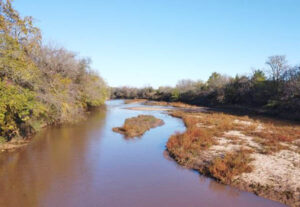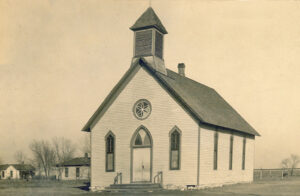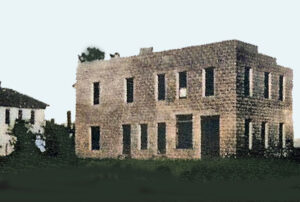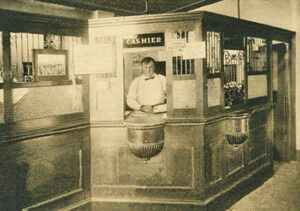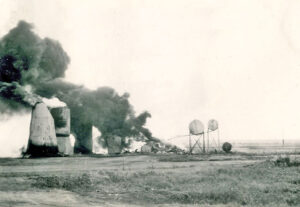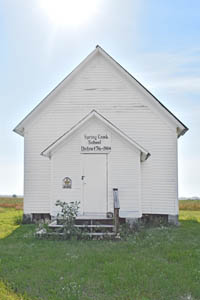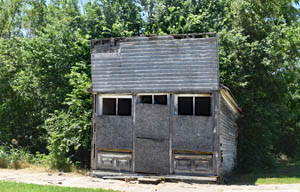Corbin, Kansas, is an unincorporated community in Falls Township of Sumner County. It is also an extinct town as it no longer has a post office.
Corbin was founded by a colony from Missouri, which purchased 80 acres of land.
Before the colony arrived, a post office was established at Hurst Crossing on June 28, 1878. It was located on the Chikaskia River, about 18 miles southwest of Wellington, the nearest railroad point. Mail was delivered four times weekly, and William D. Hurst was the postmaster.
When the Atchison, Topeka & Santa Fe Railroad ran southwest of Corbin to Caldwell, the post office moved closer to the railroad, about one mile west of town, and its name was changed to Hurst on May 9, 1881.
Mr. and Mrs. O.P. Brownback, who owned a farm at the south edge of Corbin, settled here several years before the colony arrived, making them Corbin’s oldest residents.
The first business in Corbin was a mill built by Kennedy and Gooch, followed by a doctor’s office and a drug store established by Dr. W.F. Willhoit. Kinney and Kettering built a store, Bill Allen opened a blacksmith shop, A.J. Moor built a lumber yard, Andy Ruthrauff established a hotel, and Ben Alexander opened a jewelry store.
When a post office was established on February 6, 1884, its name changed from Hurst to Corbin.
Circuit riders from the Wellington Circuit of the Methodist Episcopal Church-South conducted the earliest church services in the Corbin area. A church was organized in 1884, and two lots were purchased for $30 on September 8, 1884.
In 1887, the Chicago, Kansas, and Nebraska Railroad built a branch line north-south from Herington through Corbin to Caldwell.
Students first attended the Maple Grove School, one and a half miles southwest of Corbin.
By 1890, the Methodist Episcopal Church had been erected, free of debt and insured for $1,125.
The Chicago, Kansas, and Nebraska Railroad was foreclosed in 1891 and overtaken by the Chicago, Rock Island & Pacific Railroad. At that time, an employee hung the afternoon mail sack on a pole at the Rock Island Depot, and an employee on the train grabbed it from the pole with a hook as it was traveling at a very high speed.
By 1894, a parsonage had been built for the Methodist Episcopal Church, valued at $500.
On January 31, 1902, the safe in the Rock Island depot was blown open and wrecked by outlaws. The robbery occurred between 11:00 p.m. and 1:00 a.m., netting the robbers $10 and some jewelry. Though many heard the report of dynamite, it was muffled, and they thought it was hunters. When Rock Island agent B.S. Bonnell opened in the morning, he learned what havoc had been wrought. The safe was blown to pieces and lay scattered around the depot like the fragments of an eggshell. The building had also given away under the powerful pressure, was full of holes, and the doors and windows were forced out.
In 1904, the Spring Creek Schoolhouse, District #36, was built south of Corbin. It was a plain, one-story rectangular building measuring 27 feet by 19 feet, with three windows on each side. Students of all ages came from 1/4 mile to 2 1/2 miles to attend classes with the teachers’ monthly salary of $30. The school also functioned as a community meeting place.
In 1909, a red brick school was built at the southwest corner of Corbin, which housed grades 1-10. The higher school students attended grades 11-12 at Caldwell High School. A cafeteria, stage, and auditorium were located on the second floor.

Corbin, Kansas, 1909.
Sometime after the above photo was taken, a gazebo-style bandstand was built in the center of Main Street. A band would play there every Saturday night in the summer.
The larger building on the left was the Independent Order of Odd Fellows Hall, which housed the grocery store on the ground floor and lodge activities on the second floor. The lodge was for the International Order of Odd Fellows for men and Rebekahs for women.
At some point, the Madison Hotel and the bandstand was torn down.
In 1910, Corbin was a station on the Chicago, Rock Island & Pacific, and the Atchison, Topeka & Santa Fe Railroads. At that time, it had a money order post office with one rural route, express and telegraph offices, telephone connections, a hotel, a good local trade, Protestant churches, and a population of 174.
The Telephone Office was initially located in the southwest corner of the Madison Hotel, which was also the original site of the Corbin State Bank. When the bank moved into the newly built red brick building, the telephone office moved with it and was established in its location. Maggie Casey operated the switchboard for many years. The telephone lines were first run off hedge posts and connected to the new bank. The lines went to every house in town and some in the country. L.C. Hoppes was part owner of the phone company. His responsibility was keeping the lines up and working. Later, the Kinnards owned the telephone company before selling it to Pat Hurds.
With only one other Methodist Episcopal Church-South remaining in southern Kansas, the Corbin congregation changed to the Methodist Episcopal Church on November 1, 1914. A new building was erected on the site in 1918 and dedicated on May 11, 1919.
The Rock Island Lumber and Coal Company, owned by Bill Hess, was located on Main Street, across from Lile’sl blacksmith shop. It burned down in the early 1920s.
The Red Ball Oil Company was located just south of the railroad depot. Part of the oil warehouse was destroyed by fire in the 1920s. A group of Corbin businessmen, including Lester Hoppes, bought out the Red Ball Oil Company and renamed it Corbin Oil Company.
In the late 1920s, the Chikaskia Methodist Episcopal Church combined with the Corbin church. That building was dismantled in 1940, and the lumber was used to rebuild the Corbin parsonage.
The last year of high school in Corbin was 1928. Classes were held upstairs in two classrooms. Afterward, an unheated school bus took the high school students to Caldwell.
The Corbin State Bank struggled to stay open during the Great Depression. However, President Franklin Roosevelt rescued the bank, and it survived.
The Corbin State Bank was robbed on January 6, 1930, at about 11 a.m. Lester Hoppes, the cashier, and a clerk, Nettie Staley, were tied up and told to lie on the floor. John Walker, one of the bandits, told Hoppes that they had “cased the “own” on Sunday evening while services took place at the Corbin Methodist Episcopal Church. Afterward, Lester Hoppes and a deputy sheriff pursued the three bank robbers for a few days in southwestern Kansas. Later, one of the robbers, John Walker, killed a law officer in Colorado, and Lester Hoppes went to Carson City, Colorado, to testify.
A second lumberyard was built by Watson Wade north of the church in the early 1930s.
By the mid-1930s, many outlying rural schools had consolidated into the Corbin School.
At about the same time, E.C. “Woody” Wilson, who grew up in Corbin, was hired as the Corbin Company’s manager and bookkeeper. His office was in the northwest corner of the Corbin State Bank.
On January 29, 1936, the Corbin schoolhouse caught fire at 2:35 p.m. after the stove upstairs exploded. However, through the valiant efforts of a bucket brigade, the flames were extinguished without irreparable loss to the red brick building. Though smoke handicapped the firefighters, all students were marched to safety.
In 1939, a church union brought together the Methodist Episcopal Church, the Methodist Episcopal Church South, and the Methodist Protestant Church nationwide, and they all became simply the Methodist Church. That year, the Brethren Church in Corbin dosed and was torn down. The bell was given to the Methodists and was mounted.
Woody Wilson continued managing the Corbin Oil Company until Jerie Murphy purchased it.
In 1943, the town boasted the Corbin State Bank, a hardware/lumberyard, a grocery store, a post office, a bowling alley, the Corbin Cafe, a telephone office, the Corbin Oil Company, a service station, a blacksmith shop, two grain elevators, and a train depot. The main line of the Rock Island railroad ran through the edge of town. At that time, the Corbin Methodist Church was the center of social activity for the community, with some competition by the bowling alley.
Lester and Velma Rice bought the telephone company in about 1945. In the 1950s, it was sold to businessmen in Anthony and became the Kan-Okla Telephone Company, which moved its headquarters to Caldwell.
On August 6, 1945, a storage building south of the depot, the remaining building of the former Red Ball facility, exploded and burned. Risking his life, LaGrant Watts ran into the burning building, started the fuel transport truck, and managed to drive it out of the burning building. However, three tanks, the building burned, and another truck were burned. Fire companies arrived from Caldwell and Wellington, and people from far and near saw the fire and came to see what it was. The smoke was so heavy and black that the trains stopped the trains from passing Corbin for several hours.
In the 1940s, Herman Niebaum and Francis Conrady operated the Corbin Garage on the former site of the Madson Hotel. At that time, Frank and May Whitten owned the hardware and lumber yard business. It was later sold to Ralph and Finace Watts, who continued the business into the 1960s. The building was demolished in the 1980s.
At that time, the Corbin School had only eight grades in two rooms with two teachers.
In 1947, Bob Rice bought in with Jerie and Beatrice Murphy, and the Corbin Oil Company was renamed Corbin Oil, Inc.
That year, the Spring Creek School south of Corbin closed due to consolidation on April 18, 1947. At that time, teachers’ salaries were $125 monthly. Afterward, its grades went to Corbin School, while grades 11 and 12 attended Caldwell High School. The building was purchased for $1.00 by the Spring Creek Community Club and operated as a meeting place for many years until it fell victim to vandalization. After years of deterioration, it was moved to the Country School Museum in 2016. Today, the school, outbuildings, and playground equipment stand at 1172 S Springdale Road. Spring Creek School is on the National Register of Historic Places. The historic Belleview School also stands at this location.
In July 1949, the Corbin State Bank closed due to embezzlement. The Stock Exchange Bank of Caldwell was the parent bank. Afterward, the hardware store moved into the bank building. The same year, the Lone Star School building was purchased and moved to use as a Methodist church annex.
In the early 1950s, Corbin had a Blacksmith shop run by Mr. Neer, two elevators, the Rock Island Depot, RaymBlack’sck’s filling station, a feed store, the Corbin Oil Company run by Bob Rice and Jerie and Beatrice Murphy, a restaurant, a grocery store, a hardware store, the Corbin Bank, a lumber yard, an auto garage, the telephone office with manual switchboard, the post office, and the softball field where summer tournaments were held.
The Murphys sold Corbin Oil, Inc. to Bob Rice in the 1960s. At the same time, the Corbin School was closed when state unification took effect.
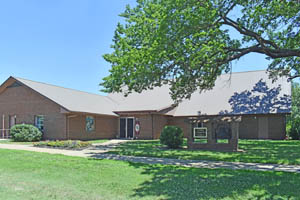
The former Methodist Church in Corbin, Kansas, is called the Country Church today. Photo by Kathy Alexander.
Major renovation of the Methodist church was completed in 1962.
In 1968, the Evangelical United Brethren Church and The Methodist Church merged nationwide, and the local church name was changed to Corbin United Methodist Church.
The post office was discontinued on February 16, 1974.
In 1975, Corbin Oil Inc. was renamed Rice Oil Co. when Bob Rice became a distributor for Mobil Oil. In 1976, he also became a distributor for Getty Oil, and Bob’s sons Bill and Brent joined Rice Oil within a few years.
In 1976, a new Methodist sanctuary was built adjacent to the educational unit for approximately $75,000. Consecration services were held on November 28, 1976.
The Chicago, Rock Island, and Pacific Railway closed in 1980 and was reorganized as the Oklahoma, Kansas, and Texas Railroad.
Brent Rice bought the Corbin service station from Pauline Black in 1984.
Rice Oil Co. officially closed in the late 1990s.
Today, Corbin has a few scattered homes, several old vacant business buildings, an intact baseball field, and a still-active church. The community is served by Caldwell USD 360 public school district.
Corbin is about 6.5 miles northeast of Caldwell and 13 miles southwest of Wellington, near the intersection of S Mayfield Rd and W 110th St S, next to the railroad.
©Kathy Alexander/Legends of Kansas, July 2024.
Also See:
Extinct Towns of Sumner County
Sources:
Blackmar, Frank W.; Kansas: A Cyclopedia of State History, Vol I; Standard Publishing Company, Chicago, IL 1912.
Country School Museum
Memories of Corbin
National Register of Historic Places
Wikipedia
Wizard of Kansas


